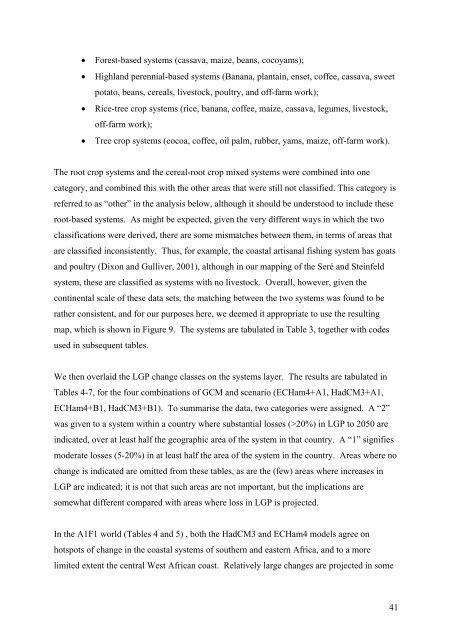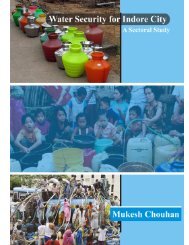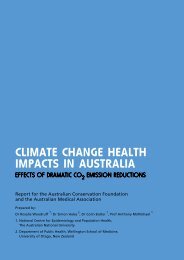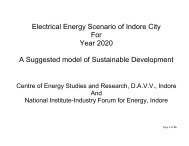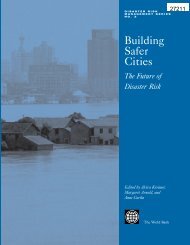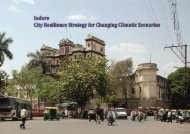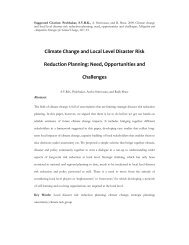Mapping climate vulnerability and poverty in Africa - CGSpace Home
Mapping climate vulnerability and poverty in Africa - CGSpace Home
Mapping climate vulnerability and poverty in Africa - CGSpace Home
Create successful ePaper yourself
Turn your PDF publications into a flip-book with our unique Google optimized e-Paper software.
• Forest-based systems (cassava, maize, beans, cocoyams);<br />
• Highl<strong>and</strong> perennial-based systems (Banana, planta<strong>in</strong>, enset, coffee, cassava, sweet<br />
potato, beans, cereals, livestock, poultry, <strong>and</strong> off-farm work);<br />
• Rice-tree crop systems (rice, banana, coffee, maize, cassava, legumes, livestock,<br />
off-farm work);<br />
• Tree crop systems (cocoa, coffee, oil palm, rubber, yams, maize, off-farm work).<br />
The root crop systems <strong>and</strong> the cereal-root crop mixed systems were comb<strong>in</strong>ed <strong>in</strong>to one<br />
category, <strong>and</strong> comb<strong>in</strong>ed this with the other areas that were still not classified. This category is<br />
referred to as “other” <strong>in</strong> the analysis below, although it should be understood to <strong>in</strong>clude these<br />
root-based systems. As might be expected, given the very different ways <strong>in</strong> which the two<br />
classifications were derived, there are some mismatches between them, <strong>in</strong> terms of areas that<br />
are classified <strong>in</strong>consistently. Thus, for example, the coastal artisanal fish<strong>in</strong>g system has goats<br />
<strong>and</strong> poultry (Dixon <strong>and</strong> Gulliver, 2001), although <strong>in</strong> our mapp<strong>in</strong>g of the Seré <strong>and</strong> Ste<strong>in</strong>feld<br />
system, these are classified as systems with no livestock. Overall, however, given the<br />
cont<strong>in</strong>ental scale of these data sets, the match<strong>in</strong>g between the two systems was found to be<br />
rather consistent, <strong>and</strong> for our purposes here, we deemed it appropriate to use the result<strong>in</strong>g<br />
map, which is shown <strong>in</strong> Figure 9. The systems are tabulated <strong>in</strong> Table 3, together with codes<br />
used <strong>in</strong> subsequent tables.<br />
We then overlaid the LGP change classes on the systems layer. The results are tabulated <strong>in</strong><br />
Tables 4-7, for the four comb<strong>in</strong>ations of GCM <strong>and</strong> scenario (ECHam4+A1, HadCM3+A1,<br />
ECHam4+B1, HadCM3+B1). To summarise the data, two categories were assigned. A “2”<br />
was given to a system with<strong>in</strong> a country where substantial losses (>20%) <strong>in</strong> LGP to 2050 are<br />
<strong>in</strong>dicated, over at least half the geographic area of the system <strong>in</strong> that country. A “1” signifies<br />
moderate losses (5-20%) <strong>in</strong> at least half the area of the system <strong>in</strong> the country. Areas where no<br />
change is <strong>in</strong>dicated are omitted from these tables, as are the (few) areas where <strong>in</strong>creases <strong>in</strong><br />
LGP are <strong>in</strong>dicated; it is not that such areas are not important, but the implications are<br />
somewhat different compared with areas where loss <strong>in</strong> LGP is projected.<br />
In the A1F1 world (Tables 4 <strong>and</strong> 5) , both the HadCM3 <strong>and</strong> ECHam4 models agree on<br />
hotspots of change <strong>in</strong> the coastal systems of southern <strong>and</strong> eastern <strong>Africa</strong>, <strong>and</strong> to a more<br />
limited extent the central West <strong>Africa</strong>n coast. Relatively large changes are projected <strong>in</strong> some<br />
41


